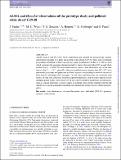Files in this item
ALMA and Herschel observations of the prototype dusty and polluted white dwarf G29-38
Item metadata
| dc.contributor.author | Farihi, J. | |
| dc.contributor.author | Wyatt, M. C. | |
| dc.contributor.author | Greaves, J. S. | |
| dc.contributor.author | Bonsor, A. | |
| dc.contributor.author | Sibthorpe, B. | |
| dc.contributor.author | Panic, O. | |
| dc.date.accessioned | 2014-12-08T15:01:02Z | |
| dc.date.available | 2014-12-08T15:01:02Z | |
| dc.date.issued | 2014-10-21 | |
| dc.identifier | 157833443 | |
| dc.identifier | 112d0d38-a76d-4ae9-90c3-84b1fce283fe | |
| dc.identifier | 000342926300062 | |
| dc.identifier | 84928319340 | |
| dc.identifier | 000342926300062 | |
| dc.identifier.citation | Farihi , J , Wyatt , M C , Greaves , J S , Bonsor , A , Sibthorpe , B & Panic , O 2014 , ' ALMA and Herschel observations of the prototype dusty and polluted white dwarf G29-38 ' , Monthly Notices of the Royal Astronomical Society , vol. 444 , no. 2 , pp. 1821-1828 . https://doi.org/10.1093/mnras/stu1545 | en |
| dc.identifier.issn | 0035-8711 | |
| dc.identifier.uri | https://hdl.handle.net/10023/5889 | |
| dc.description | JF gratefully acknowledges the support of the STFC via an Ernest Rutherford Fellowship. AB acknowledges the support of the ANR-2010 BLAN-0505-01 (EXOZODI). MCW and OP are grateful for the support of the European Union through ERC grant number 279973. | en |
| dc.description.abstract | ALMA Cycle 0 and Herschel PACS observations are reported for the prototype, nearest, and brightest example of a dusty and polluted white dwarf, G29-38. These long-wavelength programmes attempted to detect an outlying, parent population of bodies at 1–100 au, from which originates the disrupted planetesimal debris that is observed within 0.01 au and which exhibits LIR/L* = 0.039. No associated emission sources were detected in any of the data down to LIR/L* ∼ 10−4, generally ruling out cold dust masses greater than 1024–1025 g for reasonable grain sizes and properties in orbital regions corresponding to evolved versions of both asteroid and Kuiper belt analogues. Overall, these null detections are consistent with models of long-term collisional evolution in planetesimal discs, and the source regions for the disrupted parent bodies at stars like G29-38 may only be salient in exceptional circumstances, such as a recent instability. A larger sample of polluted white dwarfs, targeted with the full ALMA array, has the potential to unambiguously identify the parent source(s) of their planetary debris. | |
| dc.format.extent | 8 | |
| dc.format.extent | 937268 | |
| dc.language.iso | eng | |
| dc.relation.ispartof | Monthly Notices of the Royal Astronomical Society | en |
| dc.subject | Stars: abundances | en |
| dc.subject | Circumstellar matter | en |
| dc.subject | Stars: individual: (G29-38) | en |
| dc.subject | Planetary systems | en |
| dc.subject | White dwarfs | en |
| dc.subject | Extrasolar minor planets | en |
| dc.subject | Poynting-Robertson drag | en |
| dc.subject | Gaseous debris disc | en |
| dc.subject | Final mass relation | en |
| dc.subject | Collisional evolution | en |
| dc.subject | Rocky planetesimals | en |
| dc.subject | Brown dwarf | en |
| dc.subject | DZ stars | en |
| dc.subject | MU-M | en |
| dc.subject | Accretion | en |
| dc.subject | QB Astronomy | en |
| dc.subject | QC Physics | en |
| dc.subject.lcc | QB | en |
| dc.subject.lcc | QC | en |
| dc.title | ALMA and Herschel observations of the prototype dusty and polluted white dwarf G29-38 | en |
| dc.type | Journal article | en |
| dc.contributor.sponsor | Science & Technology Facilities Council | en |
| dc.contributor.institution | University of St Andrews. School of Physics and Astronomy | en |
| dc.identifier.doi | 10.1093/mnras/stu1545 | |
| dc.description.status | Peer reviewed | en |
| dc.identifier.grantnumber | ST/J001651/1 | en |
This item appears in the following Collection(s)
Items in the St Andrews Research Repository are protected by copyright, with all rights reserved, unless otherwise indicated.

